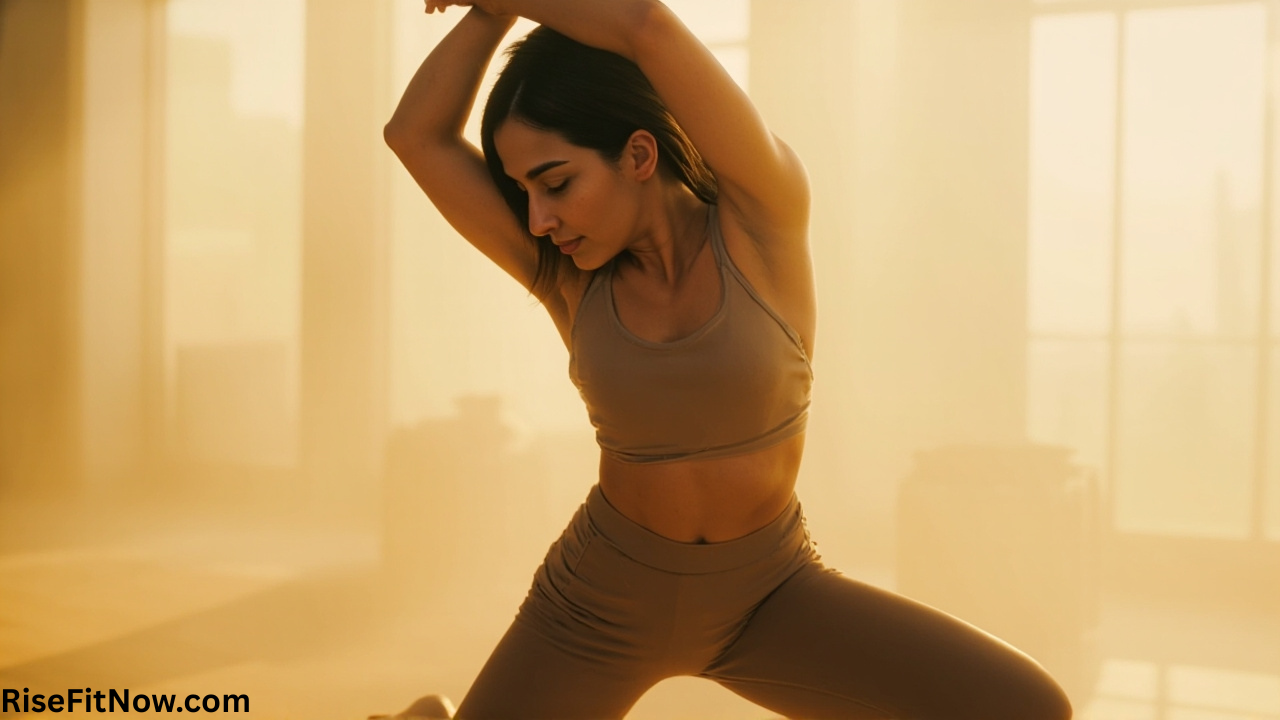Mobility & Recovery
Move better. Recover smarter. Unlock your body's real potential.

Why Mobility & Recovery Matter
Improving your mobility isn't just about flexibility — it's about moving better, recovering faster, and performing at your best. Learn how a few targeted exercises can change the way your body feels and functions every day.
5-Minute Daily Mobility Routine to Reduce Pain
Build discipline. Not just muscle.
When people think about fitness, they often skip one key element: mobility. However, staying mobile isn’t optional — it’s essential. Without it, you may feel stiff, lose range of motion, or even set yourself up for injuries. Fortunately, it only takes five minutes a day to make a real impact. In other words, small habits lead to major change. That being said, consistency is what makes the difference.
Why Mobility Matters
Mobility work goes beyond stretching. In fact, it improves joint health, posture, and muscular coordination. That’s why it’s crucial whether you're lifting weights, running, or simply trying to get through a busy day without tightness.
Moreover, it supports your long-term goals. You recover faster. You perform better. And you reduce your chances of setbacks. Because of this, mobility should be part of every fitness routine. Additionally, it enhances overall well-being and helps you stay active as you age.
The Routine (30–60 Seconds Each)
Although it’s short, this daily routine covers the essentials. Try it in the morning or after training. As you’ll see, each movement serves a clear purpose. More importantly, these movements are beginner-friendly. Even better, they require no equipment.
- Cat-Cow Stretch — Helps your spine stay fluid and responsive. In addition, it prepares your back for the day ahead. As a result, you may notice less tightness and stiffness throughout the day.
- World’s Greatest Stretch — Opens up hips, hamstrings, and upper back. For example, this helps with squats and lunges. More importantly, it supports your overall flexibility.
- Hip Circles — Activates the joints you need for walking, squatting, and balance. That means fewer aches over time. Furthermore, it wakes up your nervous system.
- Arm Swings & Shoulder Rolls — Loosens up tension from screens and lifting. As a result, your upper body moves with more freedom. Additionally, it can help improve posture.
- Ankle Circles — Small move, big benefits for balance and joint stability. Still, they’re often overlooked — don’t skip them! Even though they seem minor, they support better footwork and control.
These movements may seem simple. Even though they don’t take long, they create a powerful foundation. Done consistently, they build a stronger, more mobile you. Therefore, don’t underestimate their effect over time.
How to Use It
You can do this routine as a quick reset during the day or integrate it into your training sessions. Some people prefer mornings. Others use it after workouts to cool down and feel restored. Either way, it’s about building consistency. Therefore, the best time to do it is the time you’ll actually stick with.
As a result, you’ll feel better, move better, and reduce pain over time. More energy, fewer aches — all from just five minutes a day. Above all, you’ll build momentum that supports your overall fitness goals.
Want to Go Deeper?
- → Try our Dynamic Warm-Up Guide to activate your body before training.
- → Learn more about mobility and injury prevention in this resource by the National Academy of Sports Medicine.
Final Words
Every rep matters. But so does every stretch. While it’s easy to skip mobility, choosing to care for your body daily is a sign of true discipline. After all, progress isn’t just about lifting heavier — it’s about moving better, too.
Start small. Stay consistent. And enjoy moving pain-free. Your future self will thank you. In short, five minutes a day can change everything.
“Recovery is strength in silence.”
Mobility & Recovery: Enhance Your Movement and Speed Up Your Progress
Mobility and recovery are essential parts of your fitness journey. They help improve results and prevent injuries. In fact, whether you're an athlete or just starting out, adding mobility work and recovery can change how your body feels and performs.
Why Mobility and Recovery Matter
To begin with, mobility means moving freely through a full range of motion. Recovery is the time your body needs to repair after exercise. Together, they keep your body healthy and strong:
- Flexibility and joint function improve.
- You lower the risk of injuries.
- Movement becomes smoother and more efficient.
- Soreness fades faster, and you feel more ready for the next session.
Therefore, it's smart to include both in your weekly routine. In other words, don’t just train hard — recover well too. Even so, many people forget this step.
Effective Mobility Exercises
Mobility training is simple. For example, these moves help your joints stay healthy:
- Hip Circles: Stand on one leg and move the other in a circle. This helps loosen your hips.
- Spine Rotations: On all fours, place one hand behind your head. Twist your upper body. As a result, your back gets more flexible.
- Deep Squat Hold: Sit into a deep squat for 30 seconds. Meanwhile, keep your heels down. This opens the hips and ankles.
- Cat-Cow Stretch: Arch and hollow your spine slowly. This improves flexibility and posture.
Additionally, you can do these before or after workouts. That way, they don’t take up extra time. What’s more, they help your body recover between sessions.
Easy Recovery Tips
Recovery is just as important as training. Without it, your body can't grow or get stronger. Here are a few tips to improve recovery:
- Active Recovery: Take light walks or try yoga. These help boost blood flow and reduce soreness.
- Hydration & Food: Drink water. Eat protein and foods that fight inflammation.
- Sleep: Aim for 7–9 hours each night. That’s when your muscles rebuild.
- Massage & Rolling: Use a foam roller. This helps relax muscles and reduce tension.
Moreover, listen to your body. If you need it, take an extra rest day. Not only that, but good recovery also sharpens your focus and mood.
FAQs
How often should I do mobility exercises?
Ideally, every day. But even 3–4 times a week makes a difference. Consistency is what matters most.
Can mobility training help with chronic pain?
Yes, it can. It reduces stiffness and improves comfort. However, see a doctor for long-term pain.
What’s the difference between stretching and mobility?
Stretching makes muscles longer. Mobility improves how your joints move and work together.
Trusted Resources
To learn more, explore these expert sources:
- ACE Fitness: Why Mobility Training Is Essential
- NIH: Effects of Mobility Exercises on Joint Health
- Sleep Foundation: Sleep and Muscle Recovery
To sum up, mobility and recovery help you move better and feel stronger. Start now, and let RiseFitNow support your progress.
Evening Stretch Routine to Wind Down and Recover

After a long day of movement, stress, or stillness, your body craves restoration. Fortunately, evening stretches are a simple yet powerful way to reconnect with yourself, release tension, and prepare for restful sleep.
1. Why Stretch at Night?
Stretching in the evening helps calm your nervous system, reduces stiffness from the day’s activities, and supports muscle recovery. In addition, it's a quiet ritual that signals your body: it's time to let go.
2. Start with Breath
To begin, sit or lie down comfortably. Take 5 slow, deep breaths, inhaling through the nose and exhaling through the mouth. With each exhale, allow your muscles to relax a little more.
3. The Lunge Reach
Next, step into a low lunge with one foot forward, back knee down. Extend your arms overhead and hold the stretch for 20–30 seconds. Then, switch sides. This opens up the hips and lengthens the front body.
4. Seated Forward Fold
Afterward, sit on the floor with legs extended. Gently fold forward, reaching toward your feet. Relax the neck and back. Hold for 30 seconds to release tension in the hamstrings and lower back.
5. Supine Twist
Lie on your back and bring one knee across the body for a gentle spinal twist. Breathe deeply into your side. Then, switch sides. This helps decompress the spine and ease digestion.
6. Finish in Child’s Pose
Finally, end in child’s pose with knees wide, arms forward, and forehead on the mat. Stay here for 1–2 minutes. Let gravity help you melt into the floor and fully unwind.
“Let your evening stretch be a thank you to your body — for all it carried today.”
Make this routine a habit, and your nights will become more restful, your body more balanced, and your mind more at peace.
For more evening recovery tips, visit Sleep Foundation’s guide to bedtime relaxation.
Why Mobility Work Is the Key to Lifelong Strength

Mobility is more than flexibility. It’s the foundation that allows your body to move with control, strength, and freedom — no matter your age or training level.
While strength training builds muscle and power, mobility training keeps your joints healthy and your body aligned. Neglect it, and tight hips, stiff shoulders, or nagging pain can hold you back — or even lead to injury.
1. What Is Mobility, Really?
Mobility is your ability to move through a full range of motion with stability. It involves muscle control, joint flexibility, and body awareness. In contrast to static stretching, mobility exercises are active and dynamic.
2. Why It Matters at Every Age
Over time, modern lifestyles and poor posture can chip away at your natural range of motion. By training mobility now, you’re investing in pain-free movement, better workouts, and longevity.
3. Where to Start
Focus on key areas like hips, shoulders, and ankles. Add dynamic stretches, deep squats, and controlled lunges into your weekly routine. You only need 10–15 minutes, a few times a week, to notice a difference.
4. Combine It with Strength
Mobility work enhances strength training by improving form and reducing strain. When you move better, you train better.
“Mobility isn’t optional — it’s what keeps you moving strong for life.”
Start small, stay consistent, and keep your body ready for whatever challenge comes next. Your future self will thank you.
For expert mobility exercises, visit The Prehab Guys Mobility Guide.
Stretching for Desk Workers: Simple Moves to Undo the Damage

Spending long hours sitting at a desk can take a serious toll on your body — tight hips, a stiff back, and hunched shoulders are all too common. However, with a few targeted stretches, you can begin to reverse that tension and restore mobility.
Why Desk Stiffness Happens
When you sit for extended periods, your hip flexors shorten, your core disengages, and your upper back becomes rounded. Over time, this leads to poor posture, discomfort, and reduced range of motion.
1. The Standing Lunge Stretch
First, stand near your desk and take a long step back with one foot, keeping your front knee bent. Then, reach both arms overhead and stretch upward through your spine. As a result, this opens up the hips and effectively counteracts hours of sitting.
2. Chest Opener Against the Wall
Next, place one arm against the wall at shoulder height and gently rotate your body away. As a result, this stretch relieves tightness in the chest and shoulders, helping you sit taller with less strain.
3. Seated Twist
While seated, place one hand on the opposite knee and gently twist your torso. Not only does this movement bring mobility to your spine, but it also helps release tension built up during the workday.
4. Forward Fold
From a standing position, fold forward from the hips and let your upper body hang. Consequently, this decompresses your spine and lengthens the hamstrings, promoting overall circulation.
Make It a Habit
Integrating these stretches into your daily routine — even just a few minutes at a time — can lead to big improvements in how your body feels and functions. Therefore, try doing one every hour to stay mobile and refreshed.
“Your desk job doesn’t have to keep you stiff. Small movements bring lasting relief.”
In the long run, prioritizing your mobility pays off. A flexible body leads to a clearer mind and then better performance, both in and out of work.
For more mobility tips, visit Healthline’s desk exercise guide.
Breathwork for Recovery: How Conscious Breathing Supports Healing

When we think about recovery, we often focus on nutrition, sleep, or stretching. But there’s a powerful tool right under our nose — our breath. Conscious breathing, or breathwork, is one of the most effective ways to calm the nervous system, restore energy, and support physical healing.
1. Why Breath Matters
Breathing isn’t just automatic — it’s also a powerful regulator of how we feel. Slow, intentional breathing activates the parasympathetic nervous system, which signals the body to relax, repair, and let go of tension.
2. Breathwork Reduces Stress and Fatigue
After intense training, stress hormones can linger in the body. Breathwork helps release that stress, lowering heart rate and cortisol levels. As a result, your body recovers more efficiently, and your mind regains focus.
3. Try This Simple Technique
Sit or lie comfortably. Inhale through your nose for 4 seconds, hold for 4, exhale through your mouth for 6. Repeat for 5–10 minutes. This pattern is simple but incredibly powerful for resetting the body and mind.
4. Make It a Daily Ritual
Just like stretching or hydration, breathwork becomes more effective when done regularly. Consider practicing for a few minutes after training or before sleep. Over time, you’ll notice improved mood, clarity, and physical recovery.
“In stillness, we heal. In breath, we return to ourselves.”
Don't underestimate the power of something so simple. Your breath is your ally in the recovery journey.
Learn more about recovery breathing from Healthline’s guide to breathing exercises.

